How and with what to cut the foam?

Polyfoam is a modern material that is used to solve many problems. Often, when performing various works, it becomes necessary to cut sheets of insulation or cut out small parts of a complex shape from it.
How to cut the material evenly, neatly, with a minimum amount of debris, what tools can be used for this and how to create a thermal cutter for foam plastic yourself - you will learn about all this from this article.



Peculiarities
Polyfoam is a general name for a large group of modern polymeric materials. The most common type of foam is polystyrene (expanded polystyrene). According to the manufacturing technology, it can be non-pressed, pressed and extruded. These types differ in properties, and each of them is additionally subdivided into grades with different densities. For example, there are special types of high density that can even be used to cover aerodromes. But they are quite expensive. For ordinary household tasks, as a rule, material adapted to increased loads is not needed.
Most often, non-pressed foam is used here (in the marking the first 3 letters - PSB) with a density of 15 to 35 kg / m³ (PSB-15, PSB-25, PSB-35). It consists of many round plastic cells connected to each other, inside of which there is a gas (usually carbon dioxide).
Moreover, the gas in the material is 95-98% and only 2-5% is plastics, therefore the material is very light in weight. Outwardly, it looks like a slab of many white balls fused together.

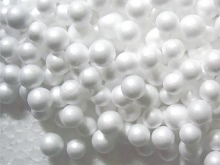

All brands of non-pressed polystyrene foam have certain properties. So, this stuff:
- excellent heat and sound insulator;
- non-toxic at room temperature;
- mold fungi and microorganisms do not grow in it;
- very light in weight, therefore easy to transport and install;
- has a low cost compared to other insulating materials (for example, roll);
- most species are moisture resistant;
- does not support open combustion, but is fusible (the melting temperature depends on the brand - the lighter ones begin to melt already at 60-90?, some - only at 270?);
- high service life - from 10 to 100 years, depending on the brand;
- fairly easy to handle.


This foam is used for the following tasks:
- as a heater and sound insulator;
- for interior and exterior decoration of premises;
- for the production of packaging and containers;
- for interior decoration (plinths, ceiling tiles, columns);
- for creating interior figurines, inscriptions and even toys.
The material is sold in sheets that differ in a wide variety of sizes: standard thickness varies from 10 to 500 mm in 1 mm increments, length and width - from 1 to 5 meters in 5 mm increments. But even with such a rich choice, it is often necessary to cut the foam sheets to fit them precisely or to create various decorative elements of an unusual shape.


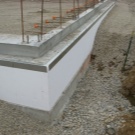



Features of Styrofoam Cutting
Expanded polystyrene has a low density, so any cutting surface (for example, an ordinary knife) cuts it. But at the same time, due to its cellular structure, the material easily crumbles, and with inaccurate cutting a lot of debris can form, and the cut itself often turns out to be uneven and bumpy.Therefore, it is important not only to cut the foam, but to do it evenly, achieving the most ideal cut and the minimum amount of chips. Making such a cut yourself at home is actually not that difficult. The main thing is to choose the right tool. It can be "cold" or "hot".
Cold methods are convenient in that they use the usual tools that are in every home:
- a sharp thin knife - for example, a clerical knife or a shoe;
- hacksaw for wood or metal;
- grinder with thin discs;
- electric jigsaw;
- thin metal string.
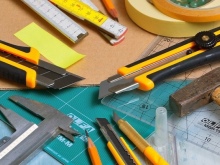


The thinner the cutting edge, the smoother the cut will be and less debris, since a thin blade cuts through the granules in the right place and has practically no mechanical effect on adjacent balls, so they remain in place, do not crumble.
However, with cold cutting, a certain amount of crumbling balls and shavings will inevitably occur anyway. Besides, only straight cuts can be made with such tools.
A smoother edge and virtually no debris for hot cuts. They allow you to create objects of any complexity and geometry. Hot cutting professionals use special machines, but their simple counterparts can be easily made by hand. For the total use:
- thin nichrome wire cutter;
- soldering iron-based thermal knife.
Next, we will consider the features of working with each tool in more detail.



How to use a knife?
For cutting thin sheets of foam (40-50 mm), the simplest tool is perfect - a knife. It can be any knife that meets the following criteria:
- the blade should be as thin as possible - so as not to touch the neighboring granules;
- have a very sharp cutting surface - the knife should easily pass through the balls, dividing them into parts, and not sawing the material (since excessive friction will lead to shedding of the granules, and the cut will be bumpy);
- the length of the cutting edge must be greater than the thickness of the sheet - so that it can cut through the foam sheet in one pass.
An ordinary office knife with a thin and wide blade will cope best with the task. But you can also use a shoe or even a kitchen knife with a thin blade with small (1-1.5 mm) teeth.

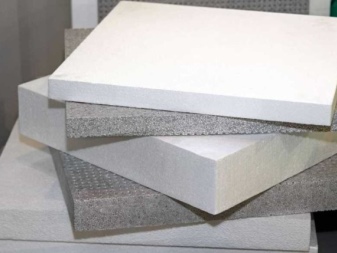
The work process is as follows.
- The Styrofoam sheet should be placed horizontally on a solid base (such as on a table or on the floor), providing sufficient work surface to prevent the sheet from slipping during operation. Cutting thin sheets of expanded polystyrene by weight or in an upright position is not worth it, since they are likely to break or severely crack and crumble. Plus, it's just plain awkward.
- Be sure to cut and mark the material before cutting: using a tape measure or ruler, take measurements and draw a line with a marker or pencil along which the cut will be made. Cutting by eye is a very bad idea.
- Even with a neat cut, a certain amount of chips and balls will still occur. Therefore, it is advisable to cover the workspace with film or newspapers, so that later it would be easy to collect garbage.
- It is advisable to pre-sharpen the blade additionally. Also, as you work, it is recommended to sharpen the knife periodically (after passing about every 200 cm of the foam sheet), since it dulls rather quickly. This can be done with a polishing wheel or grindstone. The blade can be slightly warmed up to improve cutting.
- To make the material less crumbling, the knife should be moved smoothly, without strong pressure and jerks, slightly pressing the cutting edge against the material (for this, the knife must be sharp enough).
- The cut-off part of the sheet should be carefully held so that it does not break off and does not slip on the working surface.
- Experts recommend cutting with a clerical knife in the direction "away from you", with thicker cutting tools (a shoe or a kitchen knife) - from the far edge "towards you", if the sheet area allows it.
- If the sheet is too wide, then an incision is made on one side in the direction from the edge to the middle of the sheet, then from the opposite edge, the incision line is drawn until it joins with the one already made.
- The foam cuts and breaks with a characteristic sound that annoys some. Therefore, you can use headphones for more comfortable work.
- After cutting the material, its edges can be trimmed with fine-grained sandpaper to a perfectly even state.

Cutting with a grinder and a hacksaw
Cutting styrofoam with a knife is pretty convenient. But only thin sheets (up to 50 mm) can be cut qualitatively in this way. For cutting thick plates, it is more advisable to use a hacksaw, it allows you to work with material up to 250 mm thick. The working process is almost the same as working with a knife. You can use any type of hacksaw (for wood or metal), the main thing is that it has a thin blade and small teeth. Of course, the thickness of the blade of even a thin hacksaw is still greater than that of a clerical knife, so the cut will turn out to be somewhat coarser, and there will be more shavings.
Nevertheless, the quality of the cut, with the proper accuracy, will still be good. Additionally, to achieve a better smoothness of the edge, it can be processed with sandpaper. With the help of a hacksaw, just like a knife, it is well possible not only to cut insulation plates, but also to cut out even large decorative elements with sharp corners (for example, volumetric letters for any inscription, geometric shapes, and so on).
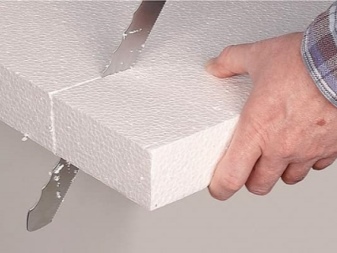

If you need to cut a lot of material (for example, a large number of plates for insulating one or several walls of the house), then working with a knife or a hacksaw will take a very long time. In these cases, it is more advisable to use automatic cutting tools, such as a grinder or a jigsaw. They significantly speed up the work (if it would take more than one day to cut with a knife, then the grinder will do it in just a few hours). Although the cut quality is somewhat coarser, and there is much more debris than when working with a knife or hacksaw, since the mechanical effect of automatic power tools is more intense. But when cutting insulation, small irregularities in the cuts are not very critical - the surface of the finished parts can be processed with a plane and sanded with sandpaper, and during subsequent installation, use construction foam for perfect joining of the plates.
The process of working with a grinder or jigsaw is also almost similar to working with a knife:
- the material is placed horizontally on a flat, comfortable surface;
- when cutting with a grinder, you must use a thin saw blade;
- the incision is carried out in smooth movements, without sharp jerks, holding the edge of the material to be sawn off;
- if, after cutting, the final processing of the edges with a plane and sandpaper is expected, then it is necessary to cut with a small allowance (1-1.5 cm).


Cold string
Ordinary steel wire can act as a thin cutting surface that leaves a neat, even cut on the foam. The optimum diameter is considered to be 0.4-1 mm. To such a wire of the required length (preferably 5-8 cm longer than the length of the future cut), handles made of any convenient material (for example, wooden or plastic) are attached on both sides. It turns out a kind of analogue of a two-handed saw, only with a very thin cutting edge.

It is more convenient to work with such a file together, as well as with a two-handed saw - especially if the cut foam plate is large. Cutting is carried out due to the forward movement of the wire along the intended line. During operation, the string heats up slightly from friction, which further improves the quality of the edge of the parts. Any number of foam boards can be cut in this way.
Their thickness can be any - from very thin (10-50 mm) to very thick (over 250 mm).



Thermal Cutting Overview
The quality of the cut can be improved if you use not a cold, but a heated cutting surface. For this, an electric voltage is applied to it, and the metal is heated. It is this principle that underlies professional styrofoam cutting devices. The choice of such devices today is huge: from compact thermal knives, pistols, portable guillotines to smart mechanisms for 3D cutting, special devices with milling heads and CNC laser machines.
Depending on the class and complexity of the equipment, its cost may also differ - from 500 rubles. up to hundreds of thousands of rubles. But for everyday tasks, for one-time use, there is usually no point in buying expensive devices. Their counterparts can be made by yourself.



Thermal Knife
The simplest and at the same time very functional device is a special knife with a heated blade. You can buy a ready-made version in the store at a price of 500 rubles. The cost of a thermal knife with several replaceable blades of different shapes will be from 1200 rubles. Such a tool is ideal for professional cutting of curly and artistic elements of any complexity. You can also cut thin sheets of insulation with a thermal knife and, if necessary, make technological holes of any shape in them.
If you don't want to buy a ready-made device in a store, or you need an option with a very non-standard shape or size of the blade, then a tool with the necessary parameters can be easily made with your own hands from a regular soldering iron.


The thermal knife is made as follows.
- The soldering iron tip is removed by unscrewing the screws on the handle.
- Instead of a sting, a blade of the desired shape is placed and fixed. Its role can be played, for example, by the blade of an ordinary or office knife, a straight razor, or a nozzle made from the end of a screwdriver flattened with a hammer. Also, an excellent cutting surface can be created if you put a thin wire with high resistance - nichrome, tungsten or even copper - instead of the tip. The wire can be curly bent, this will allow you to cut out details of any complex and non-standard shape for the embodiment of the most creative ideas.
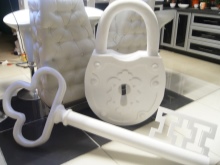


Guillotine cutter
The thermal knife is good for cutting small, irregularly shaped pieces. If you just need to evenly cut into pieces a large number of foam plates when installing insulation, then it is more efficient to use not a compact tool with a small blade, but a special guillotine machine, which will cope with the task much faster.
A heated metal wire acts as a cutting edge in the machine. This is more efficient than cutting with a cold wire. In order to cut a 50 mm thick sheet of foam plastic with a homemade machine with a hot wire, it takes about 10 seconds (with a sheet width of 1 m), the foam practically does not crumble.
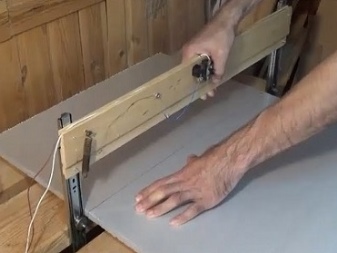
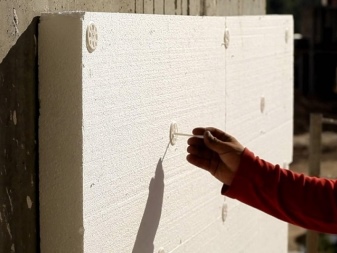
The most popular version of a homemade foam cutter is made as follows.
- First, you need to assemble the frame in the shape of the letter "H" from a non-conductive material - better from thin wooden slats, but you can also from plastic pipes.
- Bolts are attached to the ends of the lower legs of the H-shaped frame.
- A thin (0.4-1 mm) metal wire with a high resistance to electricity is attached to the bolts. It is best to use nichrome or tungsten filament. You can buy it at a hardware store or get it from an old electrical appliance (for example, an electric kettle, hair dryer, any heater except oil). In devices, such a wire is twisted into a spiral, it should be taken out, cut off a piece of the required length and straightened very carefully.
- A spring is pulled between the upper ends of the frame (or weights are suspended from each leg). This is necessary so that the string, while lengthening when heated, does not begin to sag (the heated string is 2-3 cm longer than the cold one), but remains taut and elastic in order to cut the material perfectly.
- Next, you need a small transformer. It can also be "obtained" from old technology (for example, a TV). The wires from the transformer are connected to the same bolts on which the wire is attached.


The device is ready to use, you just need to connect it to the network. You can also power the device from a low-voltage power source such as a battery. If there is no opportunity to connect to a network or a battery, then the device can even operate on batteries: three 9-volt "corona" is enough to provide 35-40 minutes of full-fledged autonomous work. When working, you need to take into account the following point. The more the thread is heated, the faster the machine cuts. However, with severe overheating, the thread will simply burst.
Experienced craftsmen use special tables to calculate the optimal work parameters, which provide data on the ratio of the supplied current and the parameters of the metal filament.
If it is not possible to adjust the settings of the equipment or it is difficult for you to understand the technical details, then you just need to monitor the color of the wire: red or scarlet color indicates optimal heating, if the thread is white-hot, it needs to be cooled (reduce the current strength or allow the equipment to cool down a little ).














The comment was sent successfully.